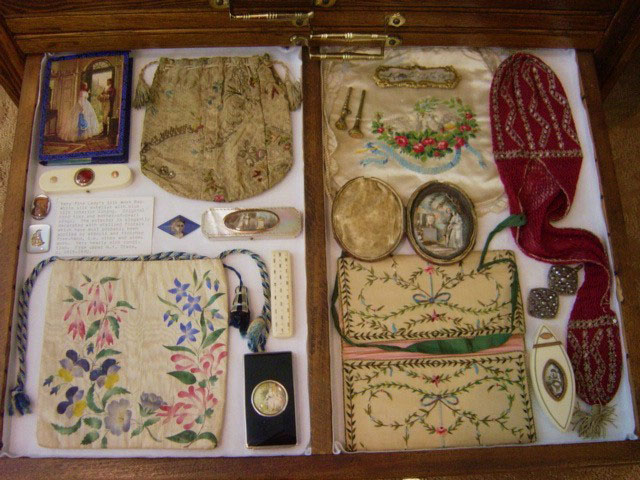Just for Fun
Antique and Vintage Purses
Guest Article written & Copyright © 2011 by
Paula Higgins and Lori Blaser
Authors of
A Passion for Purses 1600-2005, Schiffer Publishing Ltd. 2007.
Lori Blaser may be reached at apassionforpurses@yahoo.com
She may be found on Facebook under the user name Lori Rose Blaser
Ms. Blaser buys, and also sells purses from her collection.
Paula Higgins may be reached at the_higger@earthlink.net
Unless otherwise noted, all images are copyrighted by the guest authors.
Bags, used to carry personal possessions, date back to the Ice Age. In 1991, the body of a man who lived 5,300 years ago was found in the Tyrolean Alps. Among the artifacts found with him was a leather pouch containing herbs, a bone awl and flint implements. Importantly, this discovery confirms the use of bags back to prehistoric times. For the purpose of this article, we will discuss purses and bags dating from 1600 into the first half of the twentieth century.
-
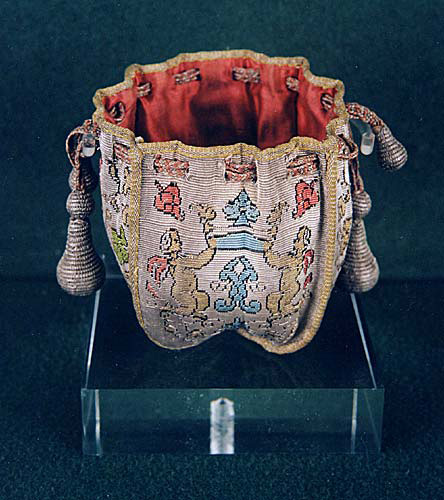 Likely French, late 17th century finely embroidered drawstring purse which belonged to Emma-Henriette Schiff von Suvero (1863-1924). Seized by the Nazi's and given to the Staatliches Kunstigewerbemuseum in Vienna. Spring 2003, the Austrian government re
Likely French, late 17th century finely embroidered drawstring purse which belonged to Emma-Henriette Schiff von Suvero (1863-1924). Seized by the Nazi's and given to the Staatliches Kunstigewerbemuseum in Vienna. Spring 2003, the Austrian government re
Seventeenth Century Purses
Seventeenth century purses can still be purchased from specialty textile and costume dealers in America, France and Britain. They were all handmade and were notable for their beautiful embroidery. “Sweet meat” purses date to the seventeenth century and are identifiable by their size, usually no bigger than 5 inches by 4 inches, and three tassels hanging across the bottom. These purses were commonly used to hold sweet smelling herbs or sachets, since people seldom bathed. There are some examples still in existence which retain their pin-pillow and knife case. Pin-pillows were very small, square pillows for straight pins, used in sewing and knife cases held a small knife for general use. The purses were made from silk and velvet, and often embroidered in tent stitch. Floral designs predominated, but extraordinary examples depicted birds and animals. Plaited drawstrings and bulbous tassels hanging at the top sides were also characteristic of sweet meat purses.
Beaded purses from the seventeenth century were made from a network of beads in angular floral designs or diaper patterns (repetitive geometric designs). Because they were made by a network technique, the designs had sharp edges and not the soft lines created by knitted beadwork. Occasionally, a purse might be decorated with a motto such as “Remember the Pore” or “Here it is Hit or Miss.” They usually had three tassels across the bottom edge as well.
Most seventeenth century purses were not mounted on frames, but every now and then one will turn up mounted on a “snap-hance” frame. Purses mounted on a curved “snap-hance” frame had to be pried open. They were quite small, made from embroidered fabrics, and could hold only a few coins. Another charming type of purse was made from a nut, cut in half, and joined by a fabric gusset.
-
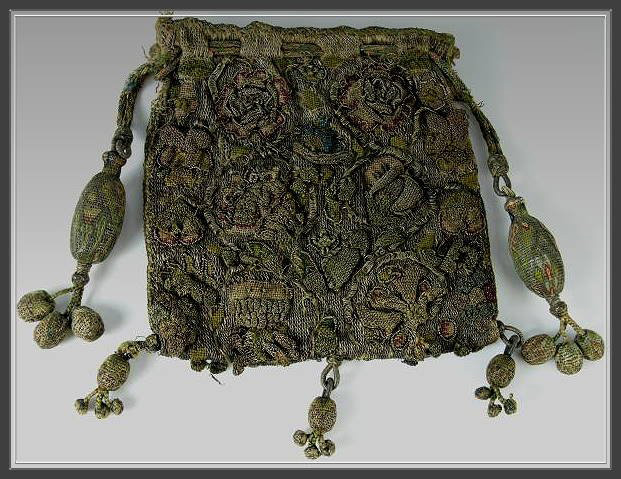 17th Century Sweet Meat Purse
17th Century Sweet Meat Purse
The Limoges Marriage purse was purportedly made to commemorate marriages. Two, oval enameled plaques, featuring the bride and groom on either side, were connected by colorful silk gussets. However, it is more likely that they depicted seventeenth century figures from the imagination of the painter. They are a very rare type of purse and locating one in all original condition, even from a specialty dealer, would be a significant find.
Pockets and misers also made their appearance during the later years of the seventeenth century. Pockets resembled saddlebags and they hung from the waist either singly or in pairs. Vertical slits in the middle provided easy access, whether worn under the skirt or over it. Early examples were embroidered or made from plain linen cloth. The Victoria and Albert Museum in London has a wonderful collection of early pockets. Misers from this period resembled knitted tubing, which was wider at the bottom. They also had a vertical slit in the middle of the knitted fabric, and had one or two ends finished with short, silk tassels.
Gaming purses made from lush velvets were used to hold gaming chips and money. Embroidered with gold and silver threads in designs featuring initials, ships and crowns, they were essentially an accoutrement of the upper classes. Short and squat in shape, they had metallic drawstrings terminating in acorn shaped drops.
-
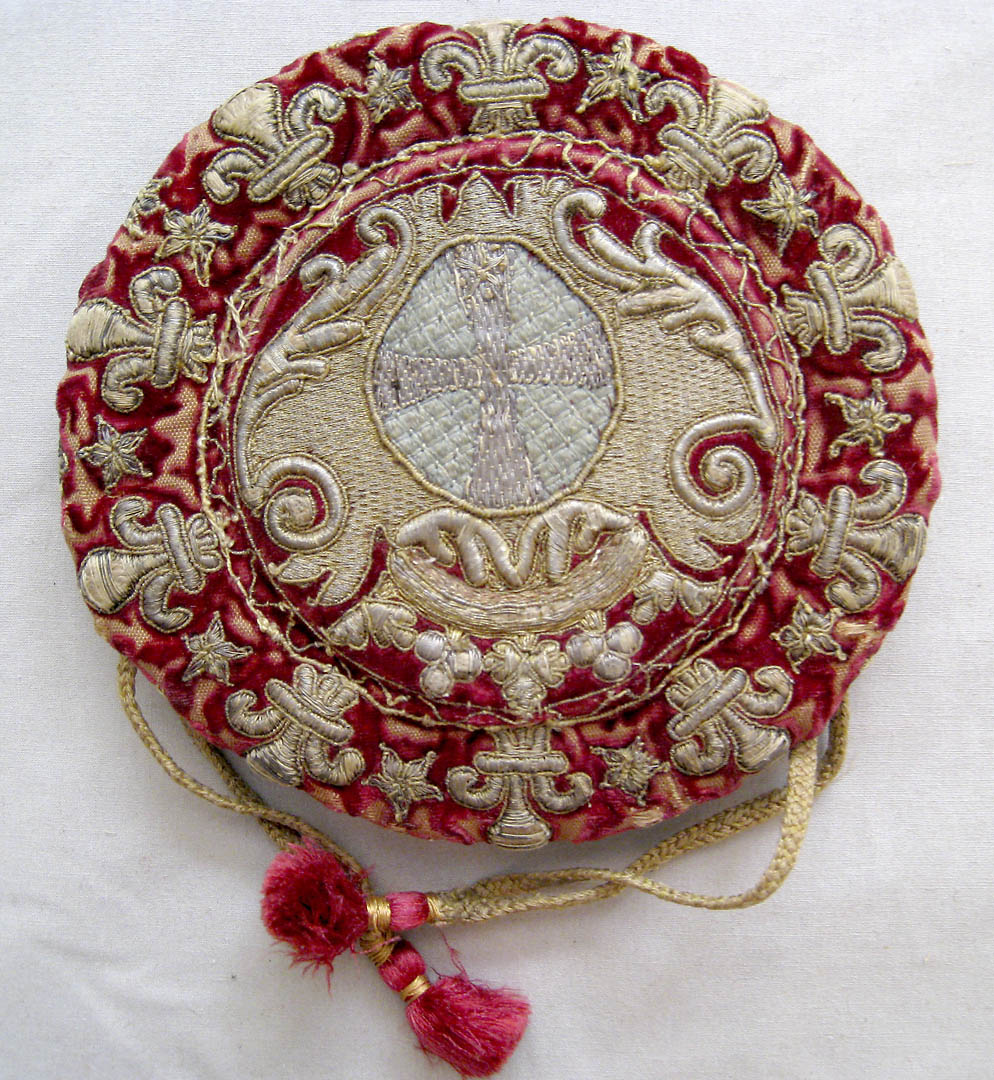 17th Century Velvet Gaming Purse, Embroidered With Metallic Thread
17th Century Velvet Gaming Purse, Embroidered With Metallic Thread
Eighteenth Century Purses
The eighteenth century produced some of the most beautifully embroidered and beaded purses ever made. The exquisite quality of 18th century embroidery has never been equaled. Polychrome silk and metal threads created a rich tapestry for reticules and pocketbooks used by the wealthy. Although many were professionally made, upper class women and girls produced work equally as fine. Purses were made from the Queen's or Rococo stitch, Irish stitch, tambour work, tent stitch, buttonhole and satin stitch. The complex Queen's stitch was a hallmark of embroidery from the 18th century and a popular method of construction for American and European pocketbooks. American examples are very desirable.
Pocketbooks were either square or rectangular shaped, folded and sometimes secured with silk tapes. Many were made in Irish stitch, which produced a flamepoint design. These Early American purses are quite expensive when offered for sale. Some had their owner's name and a date embroidered inside, under the flap. Other pocketbooks were embroidered in wool or silk crewels and featured figures, birds, animals and scenes. These scenic and figural pocketbooks reach extremely high prices and are typically only seen in museums. European pocketbooks featured more balanced and professional embroidery, worked in silks, but they often lacked the liveliness of their American counterparts.
Morocco leather pocketbooks from Constantinople were imported to Europe and America. They were embroidered with metal threads and were basically a type of souvenir purse, although some could be custom embroidered with names and dates. Turkey had a thriving export economy, much of it based on textiles.
-
 Dated 1762 Embroidered Letter Case From Constantinople
Dated 1762 Embroidered Letter Case From Constantinople
Beadworked pocketbooks are highly desirable, especially the famous sable purses from Paris. Charles Germain de Saint-Aubin created the first sable beadwork workshop in Paris. Saint-Aubin was the chief clothing designer for Louis XV. These small masterpieces are beautifully made from beads so tiny that they were styled “sable,” which means “grain of sand.” They were created by using a horizontal and vertical looping technique. Bead size ranged from 22-30 and the thread had to be pointed with shellac to string the beads onto the thread. There are graphs available which correlate the bead size with the millimeter size and beads per inch. A bead size of 22 does not mean that there are 22 beads per square inch. Beads over a size 20 are no longer produced and those that are available, are antique. A size 30 bead is reputed to have existed in sable beadwork.
The workmanship is so fine, and the beads so tiny, that there is no one alive today who can repair these purses once damaged. Designs of nymphs, scrolling Rococo flowers, cherubs, lions, and mythological creatures were depicted. Finding one with all its beadwork still intact is a true find for any collector.
-
 18th Century Sable Beaded Wallet
18th Century Sable Beaded Wallet
Misers from the eighteenth century, while uncommon, can be found. Most of the surviving eighteenth century misers are British, although American examples exist. During this period, they were fairly long in length, 19 to 24 inches. Most were knitted or netted in silks. Made with the vertical slit for accessing coins, they had sliders made from pinchbeck, gilt or steel to close off either end of the purse. Their ends were finished with silk tassels or metal charms (fishes). They were usually solid colored or striped. A few netted examples have been seen, which were embroidered with tiny sprigs.
Gilt chatelaines, with numerous appendages, were made in the Rococo Style and are literally works of art. Watches, seals, scent bottles, thimbles, vinaigrettes and scissors hung from chains attached to a hook. Made from gilt, gold, steel and pinchbeck, they were decorated with mother-of-pearl, enamel and rock crystal.
-
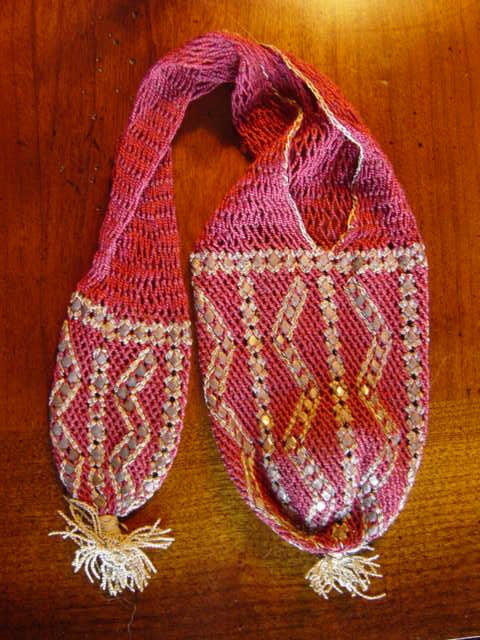 18th Century Misers
18th Century Misers
-
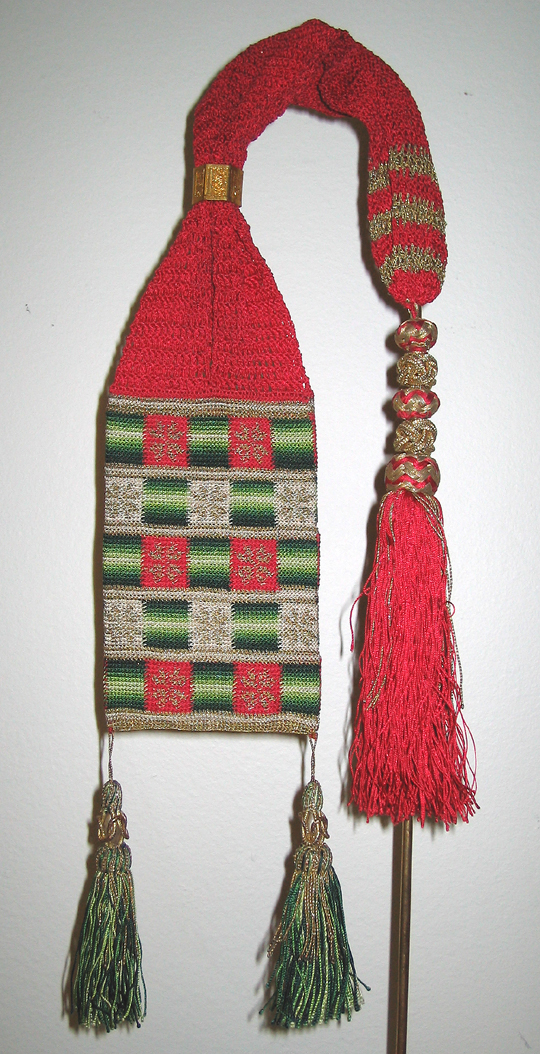 18th Century Misers
18th Century Misers
Nineteenth Century Purses
During the early years of the nineteenth century, purse design was at its height. Empress Josephine was a purse aficionado and designers worked overtime to please her and her court. Unique shapes, materials and construction were a hallmark of the period. Tortoiseshell, feathers, paper, wax, ivory, wood and straw were all used to create these early nineteenth century treasures. Reticules were still very popular, but it is at this point we see purses mounted on frames coming into their own.
Pockets and misers continued to be in use during the nineteenth century but their workmanship after 1820 was less fine. Misers were crocheted rather than knitted and pockets were usually solid pieces of cotton or linen. Although you can still find nice examples of beaded misers from c. 1830-1840, others were rather mundane and utilitarian.
-
 Early 19th Century Mother of Pearl Pique Inlaid into Tortoiseshell Leather Purse
Early 19th Century Mother of Pearl Pique Inlaid into Tortoiseshell Leather Purse
Circa 1820 Bead Knitted Basket Shape Purse
Beaded purses mounted on frames were a new fashion accessory. Many fashion historians consider beadwork of the first half of the nineteenth century to be the finest ever produced (excepting the sable beadwork). Jewel-like beads were knitted into scenes, figures, flowers and geometric designs. Lined in silks, they have survived in fairly large quantities. Earlier examples were made from fine gauge knitting, interspersed with beading, rather than being solidly beaded. They were finished with acorn tassels or beaded fringe. Designs called the “Sampler Style” by many purse collectors is characterized by three sections, typically featuring a floral, figural or scenic mid-section. They vary in sophistication, complexity and execution, but the figurals and scenics are very desirable from a collecting standpoint.
-
 Circa 1820 Bead Knitted Basket Shape Purse
Circa 1820 Bead Knitted Basket Shape Purse
Other types of purses make their appearance during this century as well. Berlin work purses are a classic mid-nineteenth century purse icon. Made from Berlin wool work patterns developed by Phillson in Germany, these purses were needle worked in Merino wools. They were often trimmed with chenille tassels on the sides. Carpetbags from the mid to late nineteenth century were made from Wilton carpets and needle work. Primarily used for travel, they are difficult to find in good condition.
Chatelaines, made in bag form, were another classic nineteenth century purse form. Souvenir coin purses from the Great Exhibition, Paris, and the Brighton Aquarium were another purse type specific to the nineteenth century. Small, but precious, they were decorated with painted or lithographed scenes, inset into tortoiseshell or gilt coin purses. They are very prized by collectors and tend to bring strong prices.
-
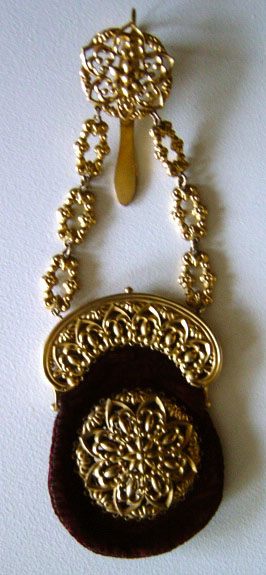 Circa 1840 Velvet Chatelaine
Circa 1840 Velvet Chatelaine
Late 19th Century Leather & Velvet Handbag
Leather handbags from c.1860 onward represent a more modern trend in purse design. Hard-bodied, they looked like smaller versions of the larger luggage pieces from the same period. They were structured and fairly small. Mounted on steel frames, with rolled leather handles, they were sturdy and useful. Plush bags were also made in this luggage form. The handbag was a trend that was to carry over into the twentieth century.
By the end of the nineteenth century, purses were larger and more utilitarian. The Industrial Age was in full steam, women were traveling further and more often, their lives were changing, and so were their purses.
-
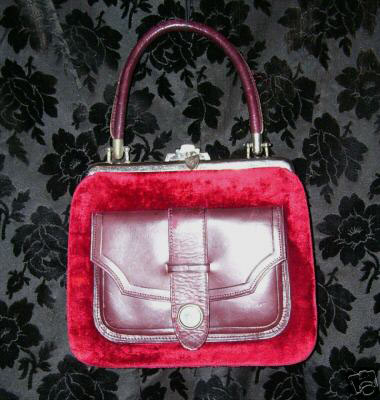 Late 19th Century Leather & Velvet Handbag
Late 19th Century Leather & Velvet Handbag
Twentieth Century Purses
Leather purses remained popular and examples by makers such as Bosco, Meeker, and Cameo were mounted on Jemco frames. These purses have survived in large numbers and can be found on eBay for reasonable prices. Structured and roomy, they can be seen in many photographs from the early twentieth century. Examples by Roycroft, a group specializing in Arts and Crafts designs, are highly desirable and quite rare. Skins of all kinds were used, including ostrich, alligator, seal, antelope and kid. New dyes produced in Germany allowed makers to use new colors such as mauve, pink and white. Designs included stylized florals, medallions and less commonly, birds and animals.
Beaded purses of extremely high quality were imported from Germany into the United States until the early 1930's. Made from tiny beads, they featured designs of castles, alpine villages, Asian scenics, eighteenth century figurals, animals, birds, the Taj Mahal, mythical creatures, florals, geometrics, the Lion and Unicorn, and the highly sought after Venetian scenics. The vast majority of these purses were made in Germany, from patterns originating in Germany. They were sewn onto frames that ranged from plain silver to highly ornate, jeweled and enameled mounts. The more elaborate the frame, the more desirable the purse is from a collecting standpoint. However, this has had the unfortunate effect of beaded purses being removed from their original frames and remounted on more spectacular ones. It is a practice that destroys the historic integrity of the purse and which purists frown on.
-
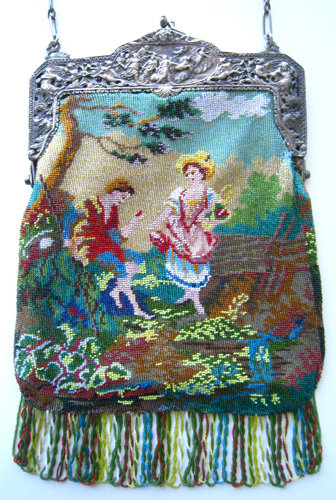 Circa 1900 Beaded Purse on Frame With Intricate Courting Scene
Circa 1900 Beaded Purse on Frame With Intricate Courting Scene
Compact, dance and mesh purses from the early years of the twentieth century are avidly collected by many women, and yes, men! Made primarily by Mandalian and Whiting and Davis, they came in a multitude of designs and colors, and reached their pinnacle in the 1920's. Handmade ring mesh had been made in America as early as 1892, but it wasn't until machine made mesh was developed that these purses appeared in volume. Types of mesh included: ring and flat armour mesh, also called “spider mesh.” A variation of the ring mesh was the extremely fine mesh known as Dresden. Dresden mesh purses create an impressionistic effect with their watercolor designs. All of these meshes were enameled and baked to make the finish permanent. Different finishes, such as the lustrous pearlized finish, added to their value. Drops and fringe hung from their bottoms, and enameled frames occasionally completed the purse. The more complex and colorful the design, and the addition of jewels, enamel, drops, drops with fringe, make the purse more desirable and valuable. Compact and dance purses were little jewel boxes attached to chains or silk cords. Inside were mirrors and fittings for lipstick, powder, coins, and perfume. Made from brass and plastics, set with faux jewels, they are icons of the 1920's.
-
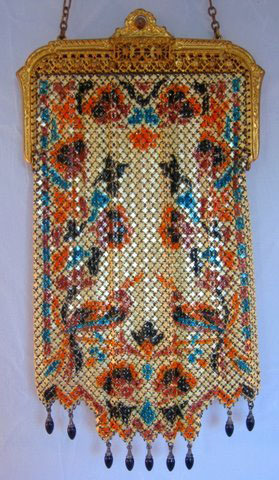 Circa 1920 Mandalian Mfg. Co Mesh Purse
Circa 1920 Mandalian Mfg. Co Mesh Purse
Tapestry and petit point purses from the first half of the twentieth century are beautiful pieces of handmade textile art. The majority of petit point purses were made in Austria. It was considered an art of national importance, to the extent that it was supported by the government. Made in the tiniest of stitches, from 900 and up to 3,000 per square inch, they were beautifully executed. Designs were varied but typically featured eighteenth century scenes, figurals, biblical scenes and florals. The classic designs of The Lion and Unicorn from the LeViste family tapestries were a common theme and are popular among collectors. Typically, they were mounted on pierced silver frames or jeweled and enameled frames. Aubusson tapestry purses made in France were woven with a weft and a warp. Designs were drawn from the “cartoons” by Boucher, Watteau and Fragonard. Also, considered masterpieces by collectors, they are quite valuable. Cartoons were large drawings used for tapestry and embroidery designs. Another variation of this type of textile purse was the silk stitched purse. Made in fine satin stitches, they create a silky effect highly sought after by all collectors. One that depicted Washington arriving by boat to New York, and the reverse side showing the signing of the Declaration of Independence, sold for approximately $5,000.
-
 Circa 1930 Petit Point
Circa 1930 Petit Point
Plastic purses in Bakelite, celluloid and Lucite are another purse style identified with the 20th century. Sculptured shapes, worked in these new plastics, transformed purse design. A wall of these architectural beauties is impressive. Mid-twentieth Lucite purses were made by Rialto, Llewellyn, Kahn, Florida, Dorset Rex, Tyrolean, Myles and Patricia of Miami. Collectors today look for Lucite in colors of pink, red and blue, decorated with rhinestones. It should be noted that these purses are subject to plastic disease, which presents as weeping, corrosion, brittleness and a vinegar odor. If this occurs, it must be removed from contact with the other plastic purses as it will spread.
-
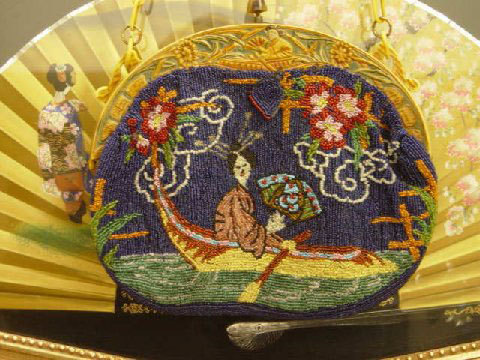 Circa 1920 Celluloid Frame Beaded Bag
Circa 1920 Celluloid Frame Beaded Bag
Minaudieres from the 1930's made by Van Cleef and Arpels were slender, hard cased containers designed to hold make-up, coins, combs, lighters and cigarettes. Cheaper versions were also made to appeal to the mass market; all are a rare find. Judith Leiber was to take this style to new dimensions later on in the twentieth century with her jeweled incarnations of dogs, cats, and Chinese boxes.
As the twentieth century progressed, fewer purses were handmade and displayed the craftsmanship so prized by collectors. Although there are exceptions which are collected due to their iconic stature, most will not withstand the tests of time, workmanship and artistry. The purses discussed in this article are desirable either from the standpoints of rarity, age, design, artistry, craftsmanship or beauty.
-
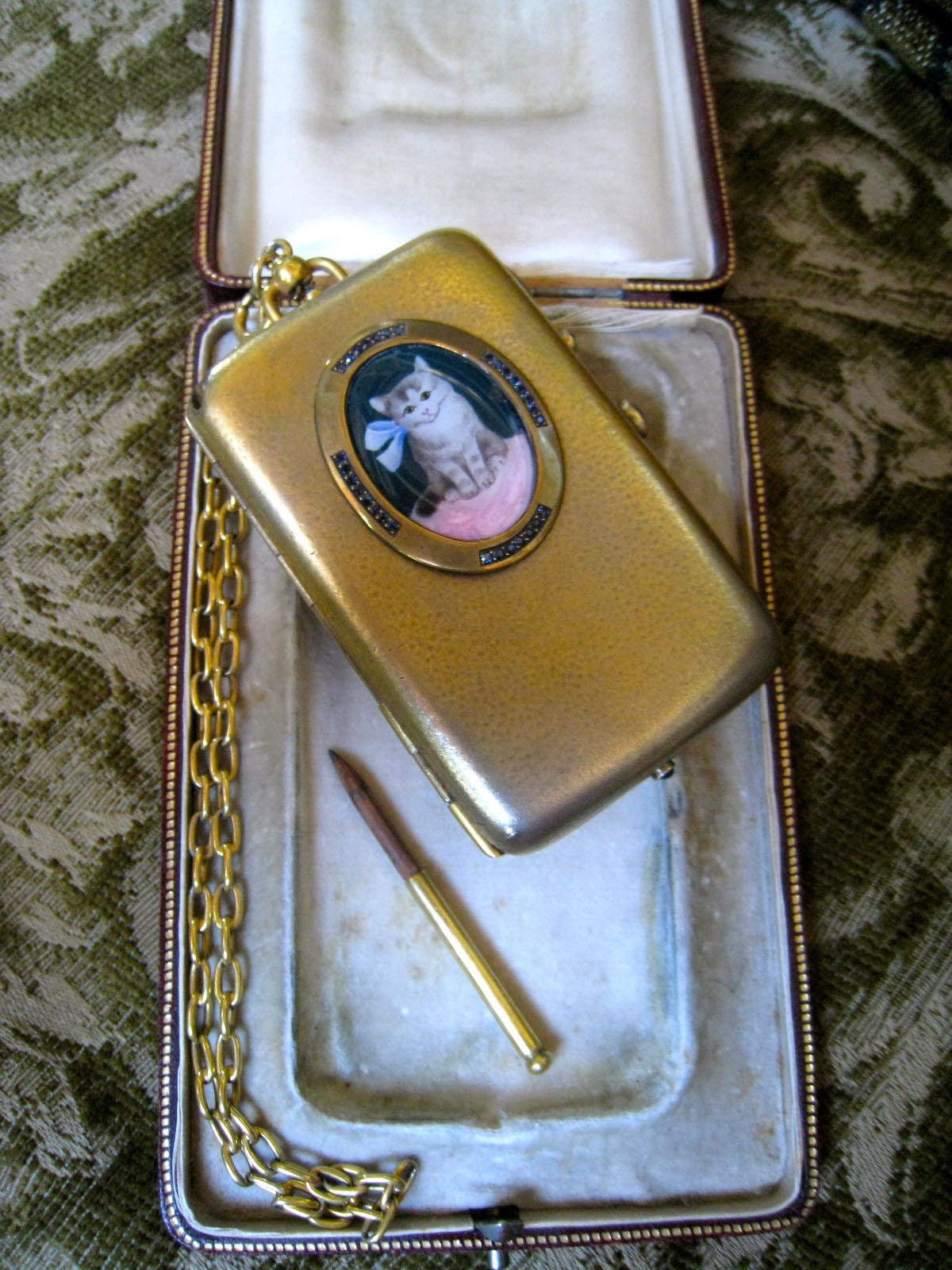 Circa 1915-1920 Compact Dance Purse
Circa 1915-1920 Compact Dance Purse
Please view the Antique Purses currently in inventory on the Textiles page.


